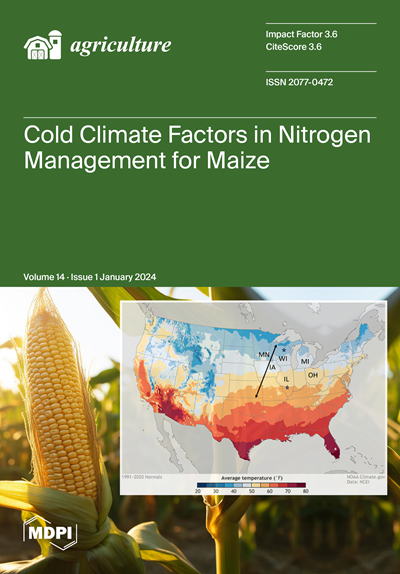Water Availability in Pumice, Coir, and Perlite Substrates Regulates Grapevine Growth and Grape Physicochemical Characteristics in Soilless Cultivation of Sugraone and Prime Cultivars (Vitis vinifera L.)
IF 3.6
2区 农林科学
Q1 AGRONOMY
引用次数: 0
Abstract
Table grape production in soilless cultivation under a controlled environment is a promising solution that addresses many of the challenges of grapevine cultivation, such as factors affecting the quantity and quality of table grape production, cultivation cost, pest management, soil degradation, soil-borne diseases, and adaptation to climate change. However, due to limited knowledge, investigation of many factors is required to effectively implement soilless cultivation, among which are the substrate’s physical-hydraulic properties and suitability for grape production. In this context, we investigate the impact of the properties of organic (coir dust) and mineral (perlite, pumice) substrates and their blend (perlite:coir) on grapevine growth and grape physicochemical characteristics of Sugraone (Superior Seedless) and Prime cultivars. Perlite substrate was the best in qualitative and quantitative production characteristics, whereas pumice substrate proved unsuitable for soilless vine cultivation. Coir and perlite:coir substrates, due to their increased ability to retain moisture, improved plant nutrition and grape quality but delayed ripening. For effective soilless cultivation of grapevines and table grape production, substrates must have the ability to maintain sufficient but not excessive moisture, suitable for supporting physiological processes and plant nutrition, resulting in smooth growth and production.浮石、椰壳和珍珠岩基质水分有效性对葡萄生长和葡萄理化特性的调控
可控环境下无土栽培的鲜食葡萄生产是一种很有前途的解决方案,它解决了葡萄种植的许多挑战,如影响鲜食葡萄产量和质量的因素、栽培成本、病虫害管理、土壤退化、土传疾病和对气候变化的适应。然而,由于知识有限,为了有效地实施无土栽培,需要对许多因素进行调查,其中包括基质的物理-水力特性和葡萄生产的适用性。在此背景下,我们研究了有机(椰子粉)和矿物(珍珠岩,浮石)基质及其混合物(珍珠岩:椰子)的性质对Sugraone(优无籽)和Prime品种葡萄生长和葡萄理化特性的影响。珍珠岩基质在质量和数量上的生产特性最好,浮石基质不适合无土栽培。椰胶和珍珠岩:椰胶基材,由于其保持水分的能力增强,改善了植物营养和葡萄品质,但延迟了成熟。为了有效的无土栽培葡萄和食用葡萄生产,基质必须能够保持充足但不过量的水分,适合支持生理过程和植物营养,从而实现顺利的生长和生产。
本文章由计算机程序翻译,如有差异,请以英文原文为准。
求助全文
约1分钟内获得全文
求助全文
来源期刊

Agriculture-Basel
Agricultural and Biological Sciences-Food Science
CiteScore
4.90
自引率
13.90%
发文量
1793
审稿时长
11 weeks
期刊介绍:
Agriculture (ISSN 2077-0472) is an international and cross-disciplinary scholarly and scientific open access journal on the science of cultivating the soil, growing, harvesting crops, and raising livestock. We will aim to look at production, processing, marketing and use of foods, fibers, plants and animals. The journal Agriculturewill publish reviews, regular research papers, communications and short notes, and there is no restriction on the length of the papers. Our aim is to encourage scientists to publish their experimental and theoretical research in as much detail as possible. Full experimental and/or methodical details must be provided for research articles.
 求助内容:
求助内容: 应助结果提醒方式:
应助结果提醒方式:


